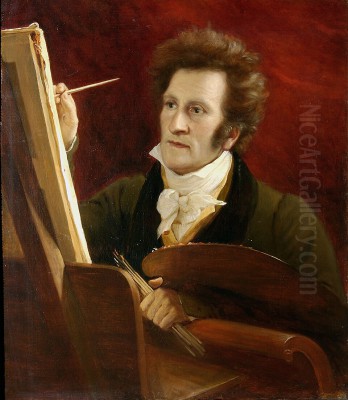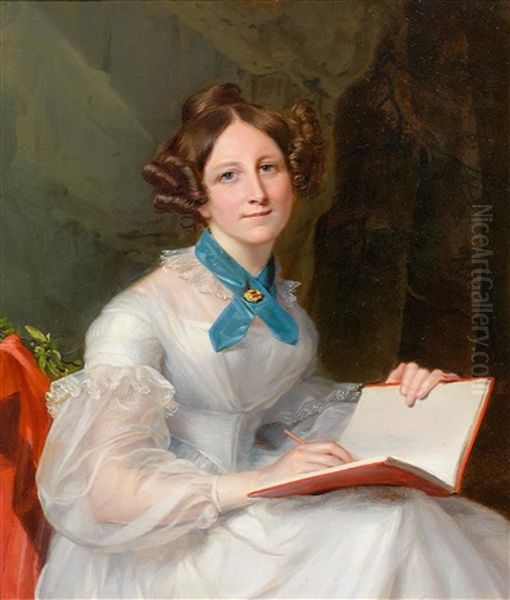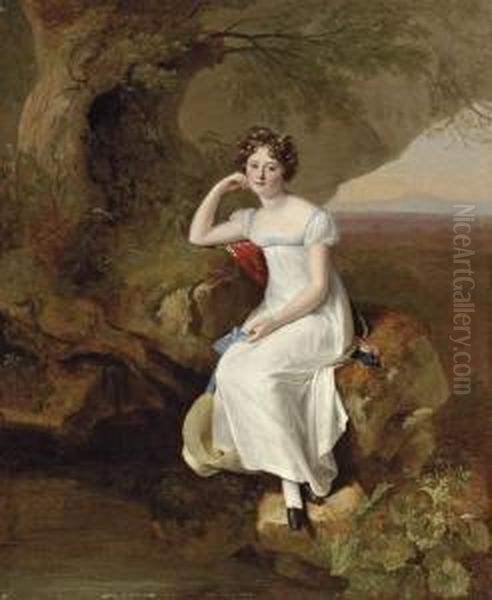
Firmin Massot (1766-1849) stands as a distinguished figure in Swiss art history, a portraitist whose delicate brushwork and insightful characterizations captured the likenesses of European aristocracy and notable figures of his time. Born in Geneva, a city renowned for its craftsmanship and intellectual vibrancy, Massot's artistic journey was shaped by rigorous training, influential travels, and fruitful collaborations, positioning him as a key proponent of the Genevan School of painting. His oeuvre, primarily consisting of portraits, reflects a sophisticated blend of Neoclassical clarity and the burgeoning influence of English Naturalism, resulting in works that are both formally elegant and intimately revealing.
Early Life and Artistic Formation in Geneva
Firmin Massot was born in Geneva on May 5, 1766, into a family with artisanal roots; his father was a master watchmaker, a profession emblematic of Genevan precision and skill. This environment likely instilled in him an appreciation for meticulous detail from a young age. His elder sister, Jeanne-Pernette Schenker-Massot, was a talented miniature painter, and her artistic pursuits undoubtedly provided an early source of inspiration and perhaps informal instruction for the young Firmin. The intimate scale and refined execution required for miniatures share common ground with the delicate precision often seen in Massot's larger portraits.
His formal artistic education commenced at the tender age of twelve, in 1778, when he enrolled in the drawing school of the Société des Arts (Geneva Art Society). This institution was a vital center for artistic training in the city. Here, Massot had the privilege of studying under several respected masters. Among them was Jean-Étienne Liotard (1702-1789), a highly acclaimed Genevan painter renowned for his pastel portraits and scenes of Turkish life, whose emphasis on truthfulness and direct observation would have been a significant early influence. Liotard's international reputation and his ability to capture character with unvarnished honesty set a high standard. Massot also learned from Louis-Ami Arlaud-Jurine (1751-1829), a painter known for his enamels and miniatures, and François Ferrière (1752-1839), another prominent Genevan artist. This foundational training in Geneva provided Massot with a strong technical grounding and exposed him to the prevailing artistic currents of the late 18th century.
The Italian Sojourn and Emergence as a Portraitist

A pivotal moment in Massot's development was his journey to Italy between 1787 and 1788. Accompanied by his patron, the councillor Jean-François Jalibert, this trip exposed him to the masterpieces of classical antiquity and the Italian Renaissance, an experience considered essential for any aspiring artist of the era. The Italian artistic heritage, with its emphasis on ideal form, balanced composition, and anatomical understanding, profoundly impacted his evolving style. While in Rome, he would have encountered a vibrant international community of artists, including figures like Jacques-Louis David (1748-1825), whose Neoclassical revolution was then at its height, or Angelica Kauffman (1741-1807), a Swiss-born artist who achieved great success in Rome and London.
The Italian experience, combined with an increasing awareness of English portraiture – perhaps through prints or direct encounters – began to shape Massot's unique artistic voice. The English school, led by luminaries such as Sir Joshua Reynolds (1723-1792) and Thomas Gainsborough (1727-1788), and later Sir Thomas Lawrence (1769-1830), was celebrated for its naturalism, elegance, and psychological depth in portraiture. Massot absorbed these influences, integrating the formal discipline of Neoclassicism with the softer, more atmospheric qualities and relaxed poses characteristic of English naturalism.
Upon his return to Geneva, Massot's enhanced skills and refined sensibilities quickly gained recognition. He made his debut at the Geneva Salon in 1789, and his talent was further affirmed when he won the grand prize at the Salon the following year, in 1790. These early successes marked his arrival as a significant artistic talent in his native city and laid the groundwork for a distinguished career. In 1795, Massot married Anne-Françoise Counis, and they would go on to have three children, grounding his personal life as his professional reputation grew.
Artistic Style: A Fusion of Grace and Precision
Firmin Massot's mature artistic style is characterized by a harmonious fusion of Neoclassical principles and the softer, more intimate approach of English Naturalism. His portraits are celebrated for their delicate brushwork, subtle and harmonious color palettes, and an almost porcelain-like finish to the skin of his sitters. He possessed a remarkable ability to render textures, from the sheen of silk and satin to the intricate details of lace and jewelry, with exquisite precision. This meticulousness, perhaps an echo of Geneva's watchmaking heritage, never overshadowed the personality of the sitter.

Unlike the often severe and heroic portrayals of French Neoclassicism, exemplified by David, Massot's figures, while composed with an underlying classical sense of balance, exude an air of gentle refinement, amiability, and quiet dignity. He often depicted his subjects in relaxed, natural poses, sometimes against simple, atmospheric backgrounds or, in line with English traditions, within landscape settings that suggested a harmonious connection between the individual and nature. This approach can be seen as a departure from the more flamboyant Rococo style of artists like Jean-Honoré Fragonard (1732-1806), whose work, though from a slightly earlier generation, represented a different sensibility focused on vivacity and sensuality. Massot’s work, by contrast, aimed for a more restrained and elegant psychological portrayal.
His handling of light was particularly adept, creating soft modulations that defined form without harsh contrasts, contributing to the overall sense of calm and grace in his paintings. He often employed a limited but sophisticated range of colors, achieving richness through subtle tonal variations rather than bold chromatic statements. This refined aesthetic made him a sought-after portraitist among the discerning clientele of Geneva and beyond. His ability to capture not just a likeness but also the sitter's social standing and inner character contributed significantly to his success.
A Portraitist of Eminence: Capturing the Elite
Firmin Massot's reputation as a premier portrait painter attracted a distinguished clientele, including members of European aristocracy, royalty, and prominent social figures. His skill in conveying both status and personality made his portraits highly desirable.
Among his most notable patrons were members of the Esterházy family. He painted portraits of Prince Nicholas II Esterházy, a significant Hungarian patron of the arts (whose collection would later form the basis of the Museum of Fine Arts in Budapest), and his wife, Princess Marie Hermenegilde Esterházy (née von Liechtenstein), known for her beauty and musical patronage, particularly of Joseph Haydn. These portraits, such as the one of Princess Marie Joséphine Hermenegilde Esterházy, would have showcased the sitters in the height of contemporary fashion, with meticulous attention to their attire and hairstyles, reflecting their elevated social standing.
Perhaps his most famous sitter was Empress Joséphine de Beauharnais (1763-1814), the first wife of Napoleon Bonaparte. Massot painted Joséphine on several occasions, and these portraits are among his most celebrated works. One such example, Josephine de Beauharnais (c. 1812), now housed in the State Hermitage Museum in Saint Petersburg, depicts the Empress with an air of gentle melancholy and refined elegance. Dressed in fashionable Empire style, adorned with exquisite jewelry (indeed, some of his portraits of Joséphine reportedly inspired jewelry designs), she is presented with a sensitivity that transcends mere imperial grandeur. These portraits highlight Massot's ability to navigate the demands of official portraiture while still imbuing his subjects with a sense of humanity. Many of his works depicting Joséphine and her circle found a home at the Château de Malmaison, her primary residence.
Other significant works include the Portrait of Madame Louise Pétronille Nicole du Pan, which exemplifies his skill in capturing the grace and poise of Genevan high society. The Portrait of Elizabeth Broadhead, which has appeared at auction, further demonstrates his appeal to an international clientele. His portrait of Eugenie Werdmüller von Elgg, now in the Kunsthalle Zürich, and the Portrait de Ariane de La Rive in the Musée d'Art et d'Histoire, Genève, are testaments to his enduring legacy within Swiss collections. Each portrait, whether of a reigning empress or a local dignitary, was approached with the same dedication to refined execution and insightful characterization.
The Genevan School: Collaborations and Contemporaries
Firmin Massot was a central figure in what is often referred to as the Genevan School of painting during the late 18th and early 19th centuries. This informal school was characterized by a blend of precise observation, often influenced by the scientific spirit of the Enlightenment, and an appreciation for natural beauty, both in landscape and human portrayal. Massot's key collaborators in forging this local artistic identity were Jacques-Laurent Agasse (1767-1849) and Wolfgang Adam Töpffer (1766-1847).
Jacques-Laurent Agasse, a close friend, was a highly accomplished animal painter, whose depictions of horses, cattle, and exotic creatures were renowned for their anatomical accuracy and vitality. Wolfgang Adam Töpffer (father of the famous caricaturist Rodolphe Töpffer) excelled in genre scenes and landscapes, capturing the daily life and picturesque scenery of the Genevan countryside with charm and wit. The three artists often worked together, leveraging their individual strengths. In collaborative pieces, Massot would typically paint the human figures, Agasse the animals, and Töpffer the landscape backgrounds. A notable example of such a collaboration is The Market of Plainpalais in Geneva, where their combined talents created a vibrant and comprehensive depiction of local life. This synergy allowed them to produce ambitious works that none might have undertaken alone. Their friendship and artistic partnership were particularly strong in their youth and continued even after Agasse moved to England in 1800, where he achieved considerable success.
Beyond his immediate collaborators, Massot worked within a broader European artistic context. His style resonated with certain aspects of the work of contemporary portraitists across Europe. In France, while David and later Jean-Auguste-Dominique Ingres (1780-1867) dominated with their powerful Neoclassicism, other artists like François Gérard (1770-1837) or Antoine-Jean Gros (1771-1835) also produced elegant portraits of the Napoleonic elite. In England, Sir Thomas Lawrence was the leading portraitist, known for his dazzling brushwork and romantic flair. Scottish painter Sir Henry Raeburn (1756-1823) captured the personalities of the Scottish Enlightenment with robust realism. Massot's work, while distinctly Genevan, shared with these artists a commitment to sophisticated representation and an understanding of the social role of portraiture. His teacher, Jean-Étienne Liotard, remained an influential figure in Swiss art, and other Swiss artists like Anton Graff (1736-1813), though primarily active in Germany, also contributed to the strong tradition of portraiture in the German-speaking world.
Later Career, Educational Role, and Legacy
Throughout the early 19th century, Firmin Massot continued to be a highly sought-after portraitist. He undertook travels to France and England between 1807 and 1828, likely to fulfill commissions and maintain connections with the wider art world, including his friend Agasse in London. His reputation for elegance and precision ensured a steady stream of patrons.
In addition to his painting career, Massot played an important role in art education in Geneva. He became the director of the École de Dessein (Drawing School) of the Société des Arts, the very institution where he had received his early training. In this capacity, he would have influenced a new generation of Genevan artists, passing on the principles of careful observation and refined technique that characterized his own work. His involvement with the Société des Arts underscores his commitment to the artistic life of his native city.
Firmin Massot passed away in Geneva on May 16, 1849, at the age of 83, leaving behind a significant body of work that documents the faces and fashions of an era. His paintings are prized for their technical mastery, their subtle psychological insight, and their embodiment of a particular Genevan elegance. He successfully navigated the shifting artistic tastes from the late Rococo and emerging Neoclassicism of his youth to the Romantic currents of his later years, always maintaining a distinctive style rooted in careful observation and refined execution.
Notable Collections and Enduring Recognition
The works of Firmin Massot are held in numerous public and private collections, attesting to his historical importance and enduring appeal. The Château de Malmaison et Bois-Préau in France, once the residence of Empress Joséphine, holds a significant collection of his portraits, particularly those related to the Empress and her circle. This underscores his close connection to one of the most prominent figures of the Napoleonic era.
In his native Switzerland, the Musée d'Art et d'Histoire in Geneva houses several of his paintings, including the Portrait de Ariane de La Rive, preserving his legacy within the city that shaped him. The Kunsthalle Zürich also features his work, such as Eugenie Werdmüller von Elgg. The State Hermitage Museum in Saint Petersburg, Russia, holds the iconic portrait of Josephine de Beauharnais, indicating his international reach even during his lifetime.
His paintings also appear in private collections and occasionally surface at major auction houses like Sotheby's, where works such as Elizabeth Broadhead have been sold, demonstrating continued market interest. The meticulous quality and historical significance of his portraits ensure their value to collectors and art historians alike. The study of his oeuvre provides valuable insights into the social and cultural milieu of late 18th and early 19th century Europe, as well as the specific artistic character of the Genevan School.
Conclusion: An Artist of Refined Sensibility
Firmin Massot was more than just a skilled craftsman of likenesses; he was an artist who imbued his portraits with a quiet elegance and a subtle understanding of human character. His ability to blend the formal rigor learned from classical traditions with the softer, more naturalistic approach favored in English portraiture allowed him to create a distinctive and appealing style. As a key member of the Genevan triumvirate with Agasse and Töpffer, he contributed significantly to the vibrancy of the city's artistic scene. His portraits of European royalty, aristocracy, and Genevan society serve as a graceful and enduring record of an era, securing his place as one of Switzerland's most accomplished portrait painters. His dedication to his art, his role as an educator, and the timeless appeal of his refined aesthetic ensure that Firmin Massot remains a respected figure in the annals of European art history.